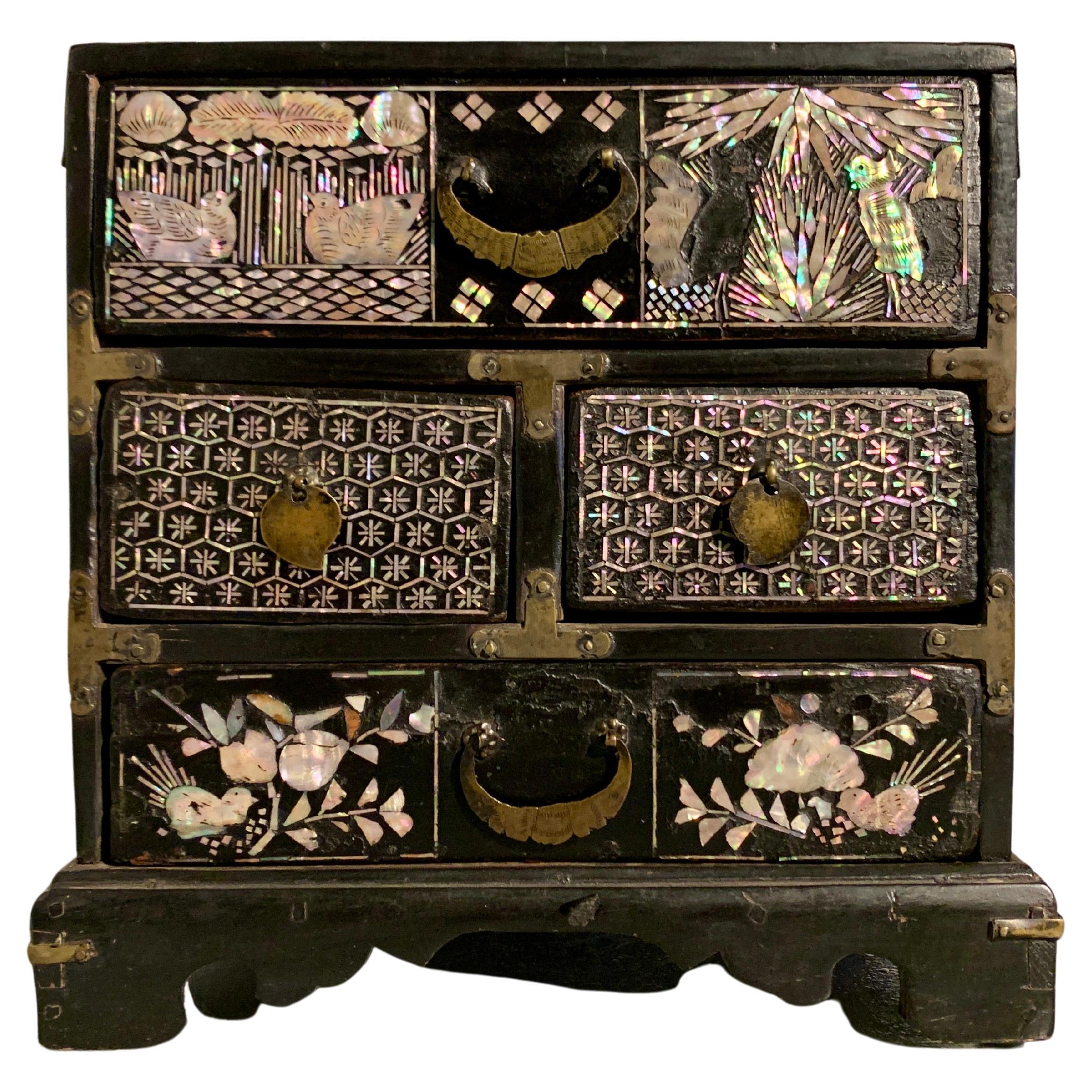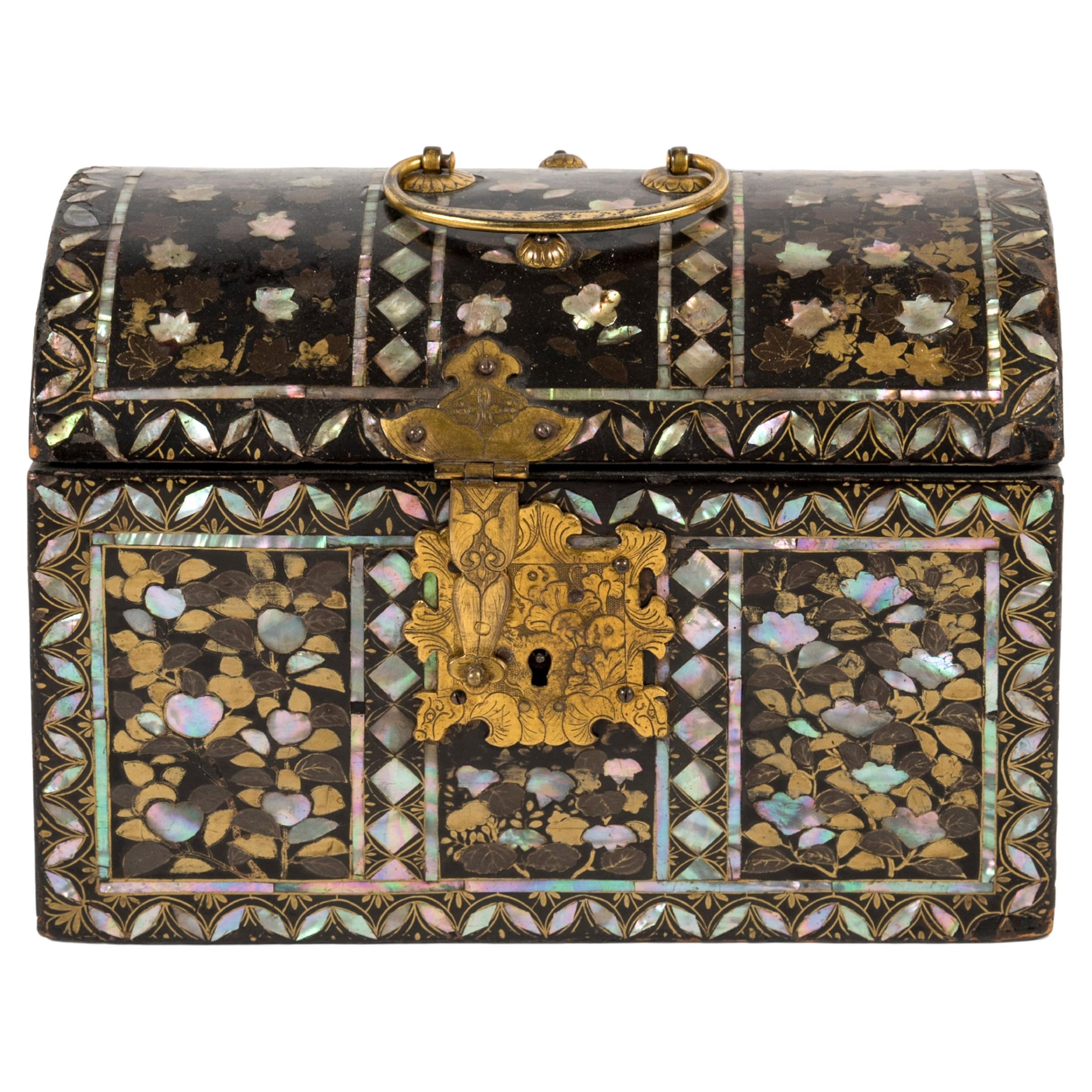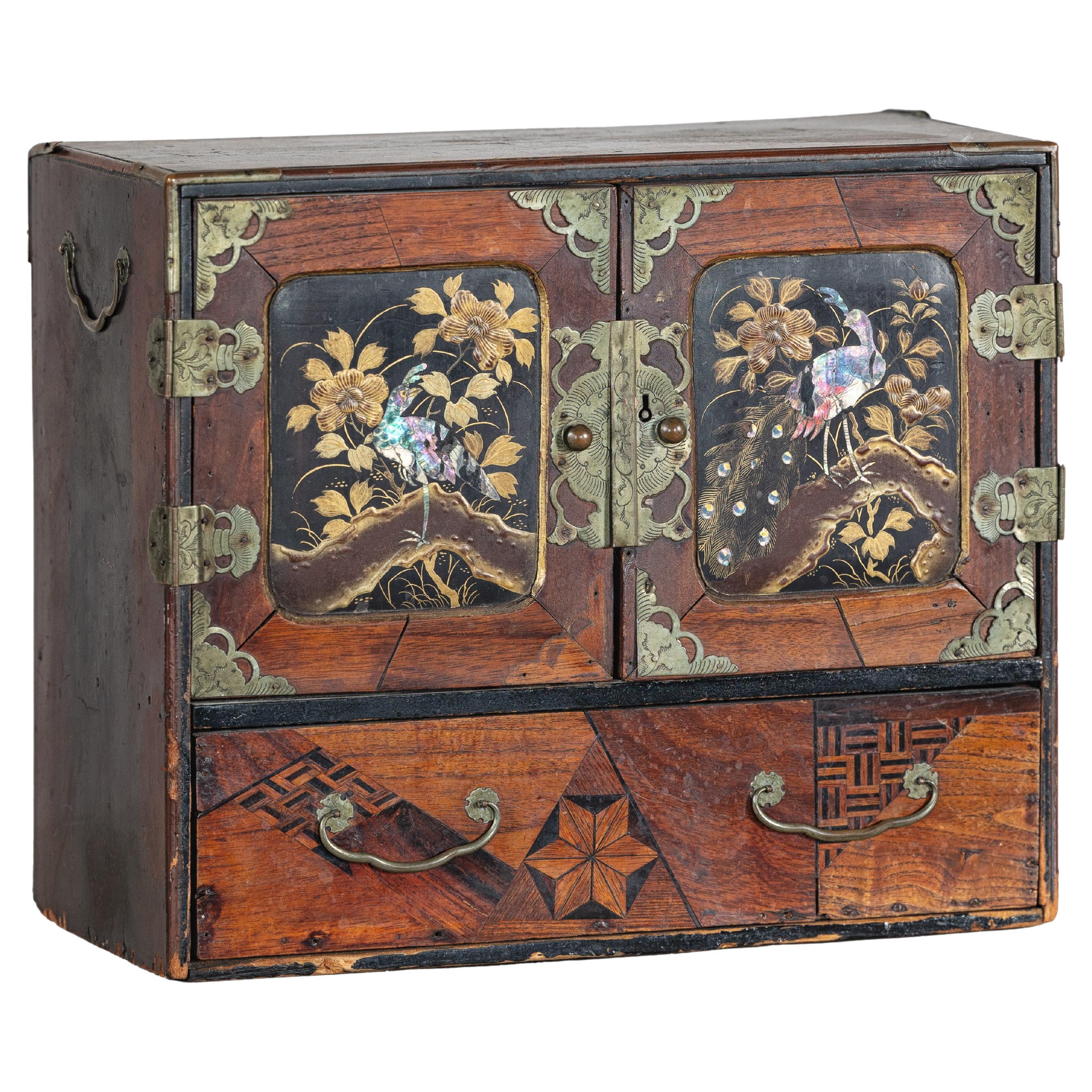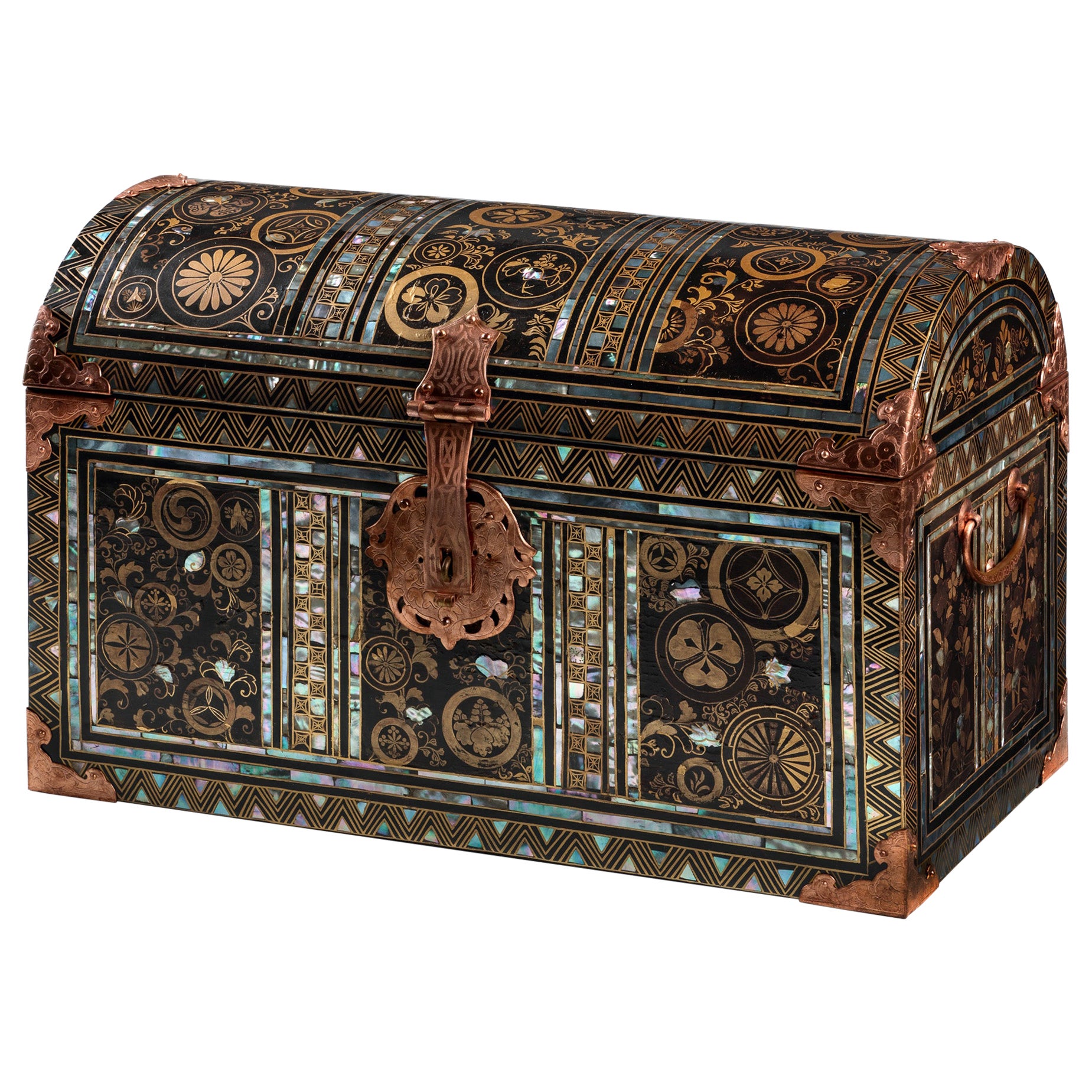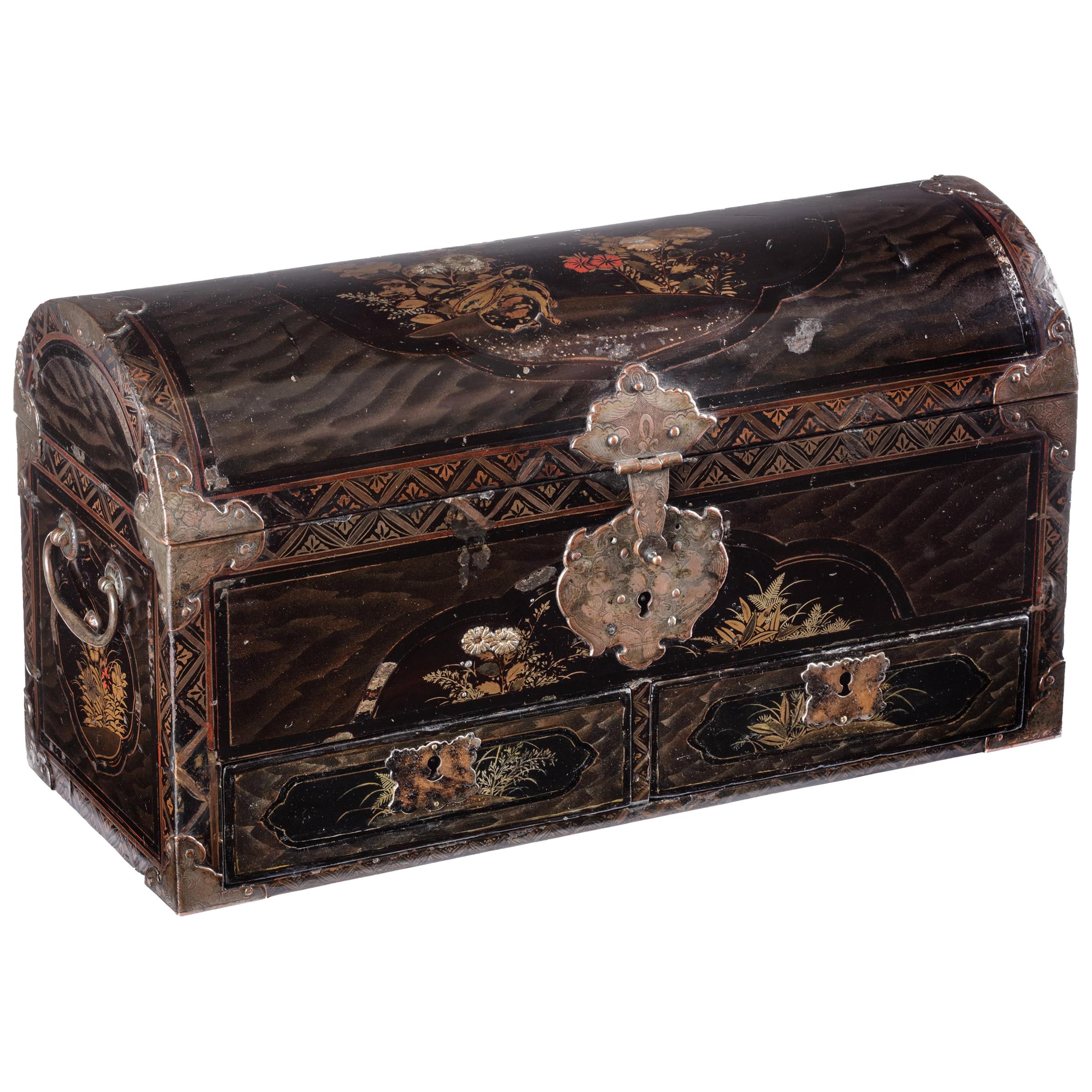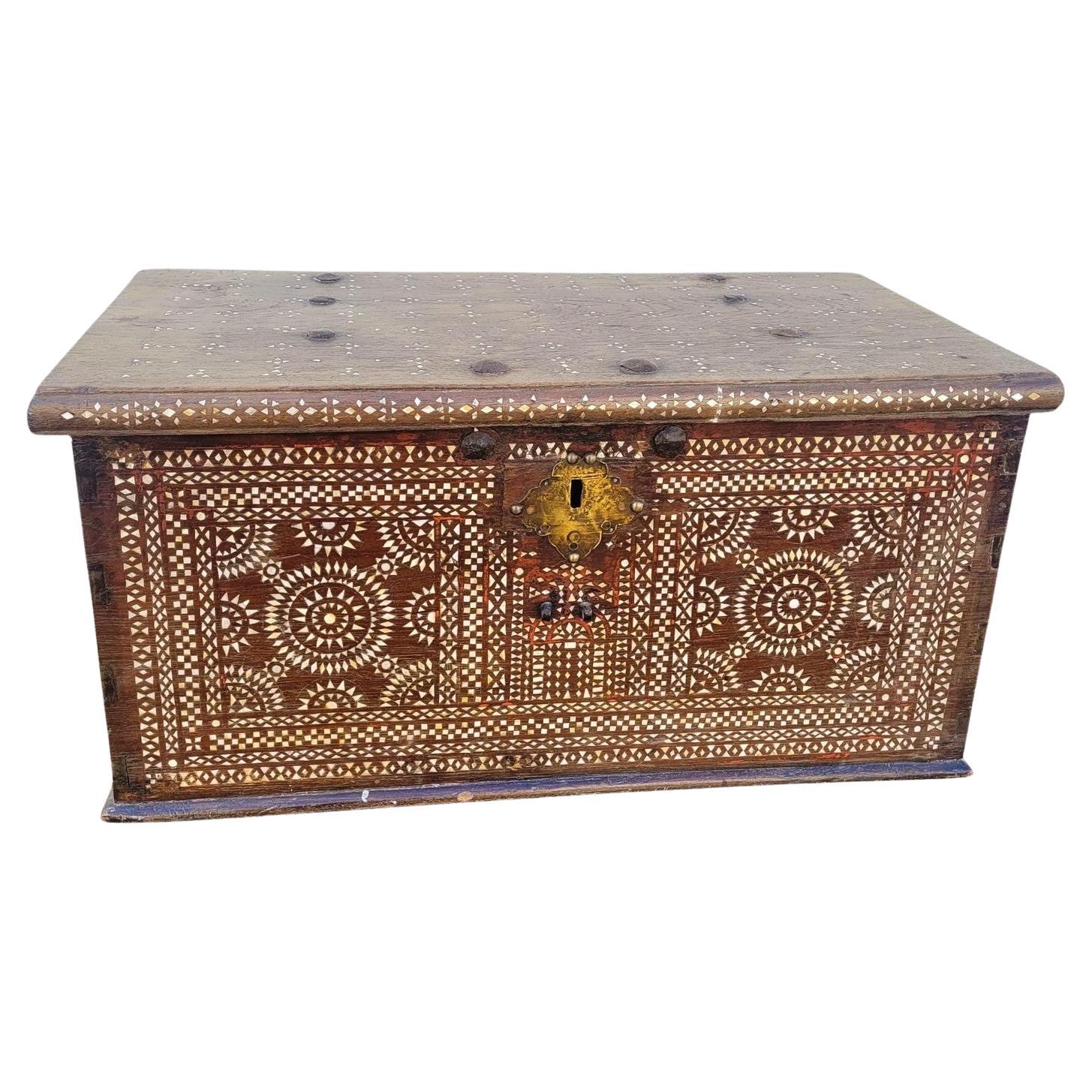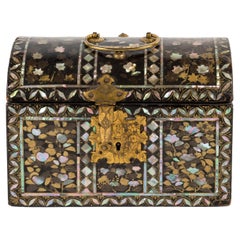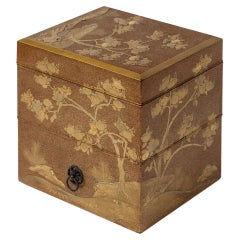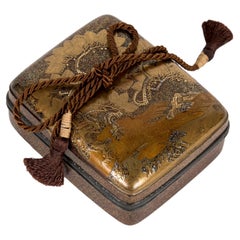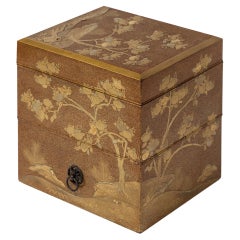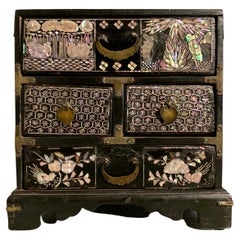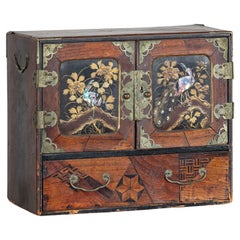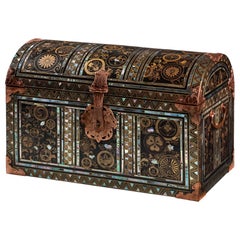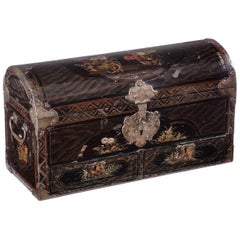Items Similar to Japanese Namban Chest adorned with cylindrical motives and mother of pearl inlay
Want more images or videos?
Request additional images or videos from the seller
1 of 9
Japanese Namban Chest adorned with cylindrical motives and mother of pearl inlay
$21,566.58
£16,054.92
€18,000
CA$29,540.83
A$32,855.85
CHF 17,156.30
MX$399,820.75
NOK 219,112.18
SEK 205,488.57
DKK 137,027.72
Shipping
Retrieving quote...The 1stDibs Promise:
Authenticity Guarantee,
Money-Back Guarantee,
24-Hour Cancellation
About the Item
Small namban style chest with a semi-cylindrical lid made of black lacquered wood (urushi) with gold lacquer (maki-e) and inlaid with mother-of-pearl (raden).
Mon style decoration (family emblem) of ginkos and chrysanthemums framed by friezes alternating three grooves and mother-of-pearl inlays. Copper fittings and black lacquer interior.
The Namban art of the 16th and 17th centuries was influenced by the contacts with the West and in particular the Portuguese who arrived in Japan from the middle of the 16th century. They are called namban-jin, literally "southern barbarians". Traders or missionaries went to Japan, bringing with them a culture totally foreign to Japan. Namban lacquerware is characterized by a decoration in gold maki-e lacquer and inlaid mother-of-pearl (raden).
Japan - Azuchi Momoyama period (1573-1603)
Height : 4.1 in (10.5 cm) - width : 6.3 in (16.2 cm) - depth : 3.7 in (9.5 cm)
- Dimensions:Height: 4.14 in (10.5 cm)Width: 6.38 in (16.2 cm)Depth: 3.75 in (9.5 cm)
- Materials and Techniques:
- Place of Origin:
- Period:
- Date of Manufacture:1573-1603
- Condition:Refinished. Wear consistent with age and use.
- Seller Location:PARIS, FR
- Reference Number:Seller: 2021-9311stDibs: LU8311242602682
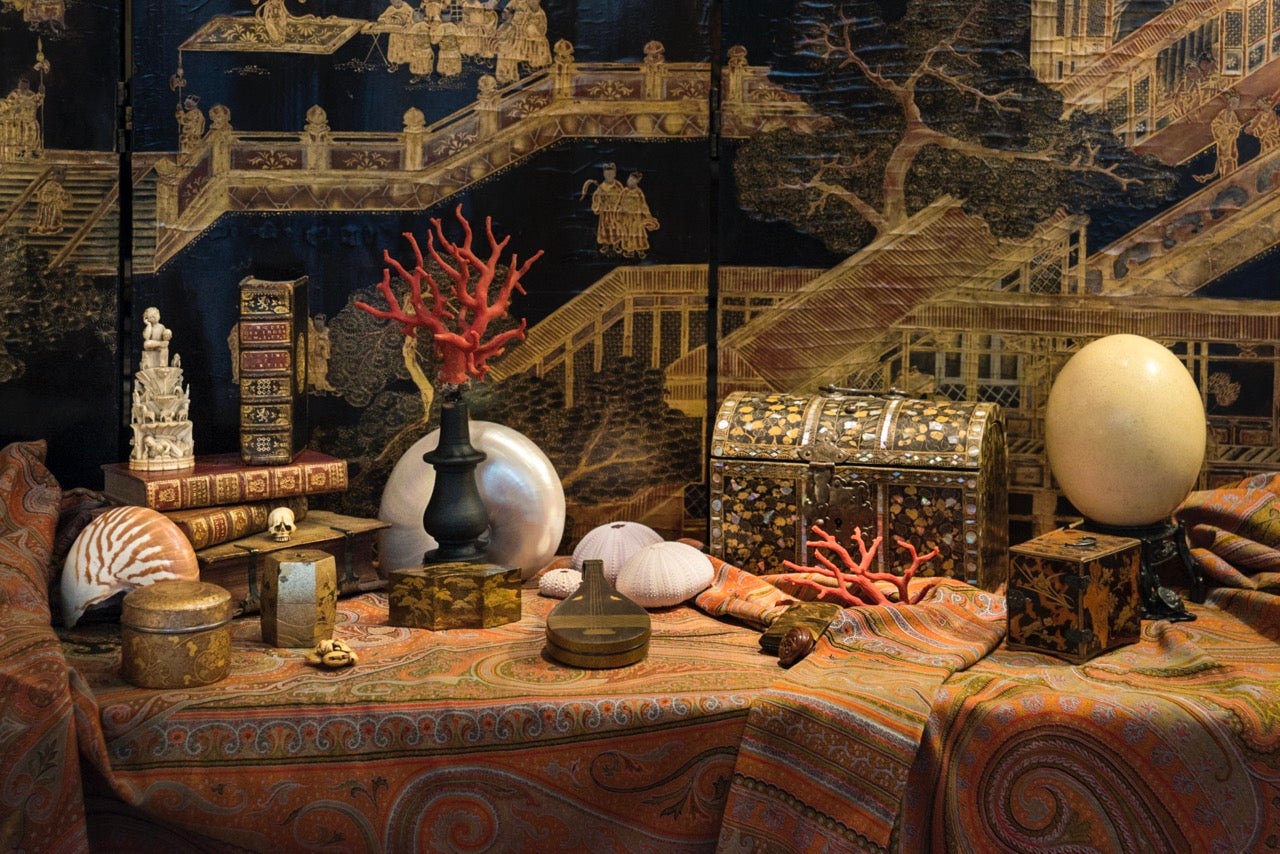
About the Seller
No Reviews Yet
Vetted Professional Seller
Every seller passes strict standards for authenticity and reliability
Established in 2013
1stDibs seller since 2023
Typical response time: Several days
- ShippingRetrieving quote...Shipping from: PARIS, France
- Return Policy
Authenticity Guarantee
In the unlikely event there’s an issue with an item’s authenticity, contact us within 1 year for a full refund. DetailsMoney-Back Guarantee
If your item is not as described, is damaged in transit, or does not arrive, contact us within 7 days for a full refund. Details24-Hour Cancellation
You have a 24-hour grace period in which to reconsider your purchase, with no questions asked.Vetted Professional Sellers
Our world-class sellers must adhere to strict standards for service and quality, maintaining the integrity of our listings.Price-Match Guarantee
If you find that a seller listed the same item for a lower price elsewhere, we’ll match it.Trusted Global Delivery
Our best-in-class carrier network provides specialized shipping options worldwide, including custom delivery.More From This Seller
View AllMomoyama Namban Chest
Located in PARIS, FR
Namban chest with a semi-cylindrical lid made of black lacquered wood (urushi) with gold lacquer (maki-e) and inlaid with mother-of-pearl (raden).
Decorated with three main bands o...
Category
Antique 17th Century Japanese Antiquities
Materials
Lacquer
$41,971
Japanese Lacquered Tebako 'Box'
Located in PARIS, FR
Tebako box with three compartments in golden and nashi-ji lacquer, decorated with golden, red, and kirigane lacquer, golden persimmon tree leaves, among rocks. The compartments are of increasing size from the top. The decoration is in continuity.
Persimmon has been cultivated in southern China for more than 2500 years and is believed to have been introduced to Japan in the 8th century. The veneer is a tree with very hard wood, similar to ebony. According to a legend, one specimen survived the atomic bombing of Nagasaki on August 9, 1945, close to the epicenter. It is therefore in Japan a symbol of strength and longevity. It is also the national fruit of the country. It is eaten as a traditional dish during New Year's Day celebrations.
Tebako literally means "portable box...
Category
Antique 1860s Japanese Lacquer
Materials
Lacquer
Japanese landscape pine kobako box Edo period 18th century
Located in PARIS, FR
Rectangular black and gold lacquer kobako box decorated with pine trees in a mountain landscape in takamaki-e, kirigane and hiramaki-e lacquer. Background in nashi-ji lacquer. Surmou...
Category
Antique 18th Century Japanese Lacquer
Materials
Gold
Japanese Tebako in Nashiji lacquer adorned with golden Persimon flowers
Located in PARIS, FR
Tebako box with two compartments in golden and nashi-ji lacquer, decorated with golden, red, and kirigane lacquer, golden persimmon tree leaves, among rocks. The compartments are of ...
Category
Antique Early 19th Century Japanese Meiji Lacquer
Materials
Gold
Fine Japanese Black and Gold Lacquer Sageju-Bako - Picnic Box
Located in PARIS, FR
Black and gold lacquer sageju-bako (picnic box) decorated with floral motifs in hiramaki-e. It includes a sake bottle, a four-compartment box with nashi-ji lacquer inside, a simple tray and a hollow tray. At the top, there is a bronze handle for transport.
The sageju-bako is divided into four superimposed boxes for food on the left; a simple tray, a sake bottle and a hollow tray on the right. They are in the shape of a plum blossom.
On the top, on both sides a phoenix. The phoenix (hôo) has an imperial and solar symbolism. This auspicious bird also embodies virtues taken from the teachings of Confucius (such as goodness, righteousness and wisdom).
The left boxes are patterned with turtles, plum tree, bamboo, cherry blossoms, water plantains near rivers. The two trays on the right have a shell and seaweed pattern. The sake bottle is decorated with a plum tree and bamboo.
On the sides, calabash decoration. Borders in saya (or sayagata) pattern, composed of Chinese swastikas...
Category
Antique Early 19th Century Japanese Lacquer
Materials
Lacquer
Miniature hokkai bako or kaioke, doll furniture replica of a traditional box
Located in PARIS, FR
Small hokkai bako or kaioke seashells game box, of circular form with its four feet, its bronzes and cordon, decorated with a motive of flowers of gold lacquer on a black lacquer bac...
Category
Antique Late 19th Century Japanese Meiji Lacquer
Materials
Gold, Bronze
You May Also Like
Korean Lacquered Wood and Mother of Pearl Inlay Chest, Joseon Dynasty, 19th c
Located in Austin, TX
A charming Korean keyaki (Japanese elm), lacquer, and mother-of-pearl inlaid personal accessory chest for a woman, Joseon Dynasty, early 19th century or earlier, Korea.
The small ac...
Category
Antique Early 19th Century Korean Scholar's Objects
Materials
Brass
Japanese Lacquer Box with Mother-of-Pearl Inlay and Parquetry Drawers
Located in Yonkers, NY
A finely crafted Japanese tabletop cabinet from the early 20th century, this compact storage piece is richly detailed with traditional decorative techniques and export-era flourishes...
Category
Early 20th Century Japanese Meiji Decorative Boxes
Materials
Wood
A rare Japanese Namban export lacquer coffer with Mon emblems
Located in Amsterdam, NL
Late Momoyama period, late 16th century
The coffer is decorated in black lacquer, urushi, on cedar wood, decorated with gold dust and silver, maki-e, and nashiji, mother-of-pearl, r...
Category
Antique 16th Century Japanese Lacquer
Materials
Silver, Copper
Fine Japanese Namban Lacquer Jewelry Casket, 17th Century
Located in Amsterdam, NL
Japanese Namban lacquer transition-style coffer with two drawers
Kyoto/Nagasaki, circa 1650
The cartouches with gilt and red decorations of leaves...
Category
Antique 17th Century Japanese Edo Lacquer
Materials
Cypress
Oriental Wooden Chest With Mother-of-pearl Marquetry, 19th Century
Located in MARSEILLE, FR
Very beautiful wooden chest (cedar?) with a richly decorated facade of mother-of-pearl marquetry, with a geometric pattern.
Each side of the chest has a different pattern.
Loc...
Category
Antique 19th Century Syrian Moorish Cabinets
Materials
Wood
Antique Korean Mother of Pearl Inlay Lacquer Tabletop Accessory Chest Joseon
Located in Atlanta, GA
An antique Korean lacquered small chest of drawers with Mother-of-Pearl inlays circa 19th century (late Joseon Dynasty). The tabletop box with multiple small drawers of various sizes...
Category
Antique 19th Century Korean Other Lacquer
Materials
Brass
More Ways To Browse
Mid Century Black Lacquer
Japanese Pearls
Wood Inlay Art
Furniture With Gold Inlay
Pearl Inlay Furniture
Mother Of Pearl Inlay Furniture
Mother In Pearl Inlay
Lacquer Cylinder
Mother Pearl Frames
Black Lacquer Inlay
Copper Inlay
Black Japanese Chest
16th Century Japanese
Black Lacquer Mother Of Pearl
17th Century Pearl
Small Asian Chest
Lacquer Chest Japan
Mother Of Pearl Chests
